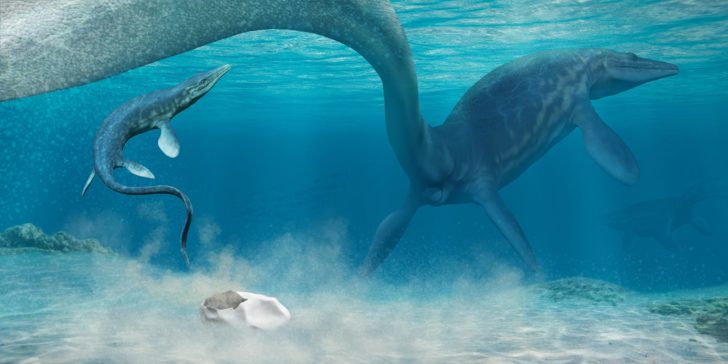In 2011, Chilean scientists discovered what looked like a deflated football among ancient marine deposits on the Antarctic coast.
The Thing has finally been identified.
Until recently, the fossilized sphere, nicknamed « The Thing » in reference to the science fiction film, had remained anonymous in the collections of the National Museum of Natural History of Chile. New research, published Wednesday in the journal Nature, suggests that The Thing is in fact a 66-million-year-old egg.

Measuring 28 centimetres long and 18 centimetres wide, it is the largest soft-shelled egg ever found, and the second largest in history. The largest egg ever found was laid by an elephant bird, a relative of the kiwi that became extinct only a few thousand years ago. Scientists have hypothesized that the egg found in Antarctica was laid by a giant marine reptile, extinct like a mosasaurus, a sea lizard.
A deflated egg !
It comes from an animal the size of a large dinosaur, but it is completely different from a dinosaur egg, » said the study’s lead author, Lucas Legendre, a geoscientist and postdoctoral fellow at the University of Texas, in a press release. « It looks a lot like the eggs of lizards and snakes, but it comes from a truly giant relative of these animals ».

Chilean scientist David Rubilar-Rogers, a member of the research team that discovered the egg, showed the fossil to scientists visiting the museum where it was kept, but most were puzzled – that is, until Julia Clarke, a geology professor in Texas, took a look at it. « I showed it to her, and after a few minutes Julia told me it could be a deflated egg, » said Rubilar-Rogers.
A prehistoric reptile.
Julia Clarke’s intuition was confirmed when powerful microscopes revealed several layers of membrane beneath the surface of the egg. According to David Rubilar-Rogers, the ancient egg closely resembles the rapidly hatching transparent eggs laid by several current species of snakes and lizards.

By analyzing the bodies and egg sizes of 259 live reptiles, the researchers determined that the species that laid the deflated football about 66 million years ago would likely have spread over a length of about 6 metres from nose to body end, not including the tail. Marine deposits close to the origin of the egg have previously yielded the remains of mosasaurs and plesiosaurs, both infant and adult.
There’s still some shadows that remain.
Many authors have hypothesized that it was a kind of nursery with shallow protected waters, a creek environment where the youngsters would have had a quiet setting to grow up, » said Lucas Legendre.
« The idea was that it was a kind of nursery with shallow protected waters, a creek environment where the youngsters would have had a quiet setting to grow up, » said Lucas Legendre.

It is possible that the ancient sea lizard laid eggs in the open sea as some sea snakes do. The reptile could also have buried its eggs on the beach, just beyond the breakers, like sea turtles do. « We can’t rule out the idea that they pushed their tails to the shore because nothing like this has ever been discovered, » said Mr Clarke.
